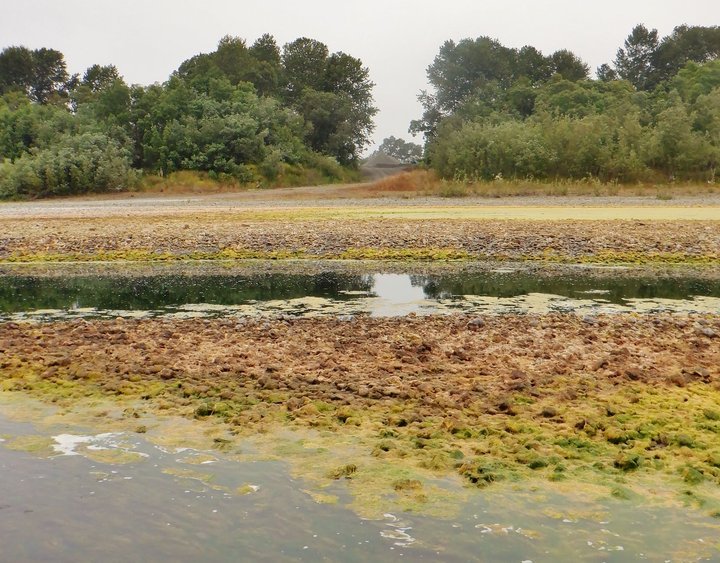
Algal blooms on the lower Eel. Photo: Eric Stockwell.
From the Humboldt County Public Health Division:
Environmental health officials are reminding community residents to be on the lookout for harmful algal blooms after a report was made of a person becoming ill following time spent in the South Fork Eel River north of Weott. State staff is currently taking water samples at this location and will post warnings on the shore.
This news comes days after testing confirmed cyanobacteria, also referred to as blue-green algae or harmful algal blooms (HABs), was found at a location in the main stem of the Trinity River east of Willow Creek and likely contributed to a dog’s death earlier this month.
Cyanobacteria can be present in any fresh water body and looks like green, blue-green, white or brown scum, foam or mats floating on the water. Warm water and abundant nutrients can cause algae to grow more rapidly than usual and these floating algal masses or “blooms” can produce natural toxins that are potent and dangerous. Dogs and children are most likely to be affected because of their smaller body size and tendency to stay in the water for longer periods.
Low flows along several local rivers including the South Fork Eel, Van Duzen and Mad Rivers, coupled with sustained high temperatures in the inland areas and record low rainfall have created the ideal conditions for rapid blooming of this harmful algae.
Since 2001, there have been 12 documented dog deaths locally where the dogs died shortly after swimming in Big Lagoon, the South Fork Eel River or the Van Duzen River. In each instance, water samples confirmed the presence of cyanobacteria in the water.
Most algal blooms in California contain harmless green algae, however, it is difficult to test and monitor the many miles of local rivers with conditions that readily change. To stay safe, it is best to assume that an algal bloom has the potential to contain toxins.
Symptoms in people may include eye irritation, skin rash, mouth ulcers, vomiting, diarrhea and cold or flu-like symptoms. Following exposure to harmful algal blooms, symptoms in dogs may include lethargy, difficulty breathing, salivation, vomiting, urination, diarrhea or convulsions.
The following guidelines are recommended for recreational users of all freshwater bodies in Humboldt County:
Keep children, pets and livestock from swimming in or drinking water containing algal scums or mats.
Adults should also avoid wading and swimming in water containing algal blooms. Try not to swallow or inhale water spray in an algal bloom area.
If no algal scums or mats are visible, you should still carefully watch young children and warn them not to swallow any water.
Fish should be consumed only after removing the guts and liver and rinsing fillets in tap water.
Never drink, cook with or wash dishes with water from rivers, streams or lakes.
Get medical attention immediately if you think that you, your pet or livestock might have been poisoned by cyanobacteria toxins. Be sure to tell the doctor or veterinarian about possible contact with cyanobacteria or algal blooms.
Join or support one of the many watershed and river organizations.
To learn more about cyanobacteria and HABs, visit the state of California’s website at mywaterquality.ca.gov/habs.
To learn more about cyanobacteria and algae on the South Fork Eel River, visit eelriverrecovery.org/algae.
To report a bloom, e-mail CyanoHAB.Reports@waterboards.ca.gov or call 844-729-6466 (toll free). Blooms can also be reported via the “bloomWatch” app which is available for free download on iTunes or Google play.
For information on conditions occurring within Humboldt County, contact the Humboldt County Department of Health & Human Services Division of Environmental Health at 707-445-6215 or 800-963-9241. Photos of suspected blooms can also be emailed to envhealth@co.humboldt.ca.us.
CLICK TO MANAGE